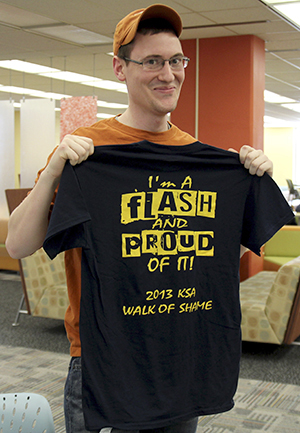Kent State pride vs. Kent State shame
April 23, 2013
“We are going to have to cite you for wearing non-Kent State apparel,” Caitlin Smith, Kent State student ambassador said to Alex Drungil, who was wearing an Ohio State University sweatshirt.
“You guys going around campus hunting [people wearing other school’s apparel] down?” Drungil asked the student ambassador.
Drungil, sophomore nutrition major, was “cited” for wearing non-Kent State apparel during the student ambassadors’ “walk of shame” week. Drungil said his Kent State pride improved because he was “ashamed.”
Student ambassadors walked across campus with free T-shirts to give to “cited” students. The T-shirts had “I’m a Flash and Proud of It” written on the back.
Carrie Circosta, assistant director of student and recent grad programs in Alumni Relations, said the intention behind the event is to increase school pride. She said the ambassadors started the “walk of shame” week in Spring 2011 and average 70 to 80 “cited” students each semester.
“It is just a really simple way, a fun way, to spread the pride of the university,” Circosta said. “It is the end of the semester. The point is just to have fun [and] spread pride. That is the goal of the Alumni Association.”
Circosta said previously, students have felt like the Alumni Center was trying to tell students what to wear, but the focus is to keep them connected to the university.
“We haven’t really got anybody really mad, but we have got people really embarrassed,” Circosta said.
Caitlin Smith, junior integrated health studies major and the student ambassador, said she has previously worn attire from other schools on campus, but working the event made her think about wearing Kent State clothes more.
“I feel like it is helpful,” Smith said. “I think it is just a fun way to get out on a nice day and let people know what it is all about.”
Circosta said the most common non-Kent State attire she notices students wearing is from The Ohio State University, Bowling Green State University and University of Akron.
T’maya Howard, freshman fashion merchandising major, said she was “cited” for wearing a University of Kentucky T-shirt.
“I woke up out of bed and threw a shirt on,” Howard said. “I got this my sophomore year [of high school] because I was considering Kentucky.”
Cory Hatfield, junior early childhood education major, was caught wearing a Texas Longhorns shirt and hat. He said he chose the outfit because it matched and was the school of his favorite athlete, Kevin Durant, who played basketball for the Longhorns.
“I mean just that it was pretty much like, ‘OK, I’ve got matching clothes,”’ Hatfield said about getting dressed Tuesday morning.
Circosta said she felt that she saw more students wearing Kent State clothing than before and that cited students have been “good sports.”
“I think they will think twice about what they wear around campus,” Circosta said. “At least they got a Kent State shirt out of it.”
The Alumni Relations staff advises the Kent State student ambassadors. Some students may view the Alumni Relations Office as a place that only calls for money or organizes homecoming, but the office also helps serve students and the Kent community.
The following are a few misconceptions Circosta said students have when they talk to her and other staff members about the Alumni Relations Office.
Misconception 1: Alumni Relations isn’t accessible
Circosta, whose position deals with student outreach, said that the office plans many on-and-off campus events.
“I look at different events and outreach efforts,” Circosta said. “[Students] think we don’t have resources for them now.”
Nancy Schiappa, associate director of Alumni Relations, said the office tries to connect students and graduates back to the institution.
“[It] gives you a chance to come back to where you know friendships were created,” Schiappa said.
Misconception 2: Alumni Relations doesn’t work with students on campus
Alumni Relations advises the student ambassadors, a group of 50 distinguished student leaders who represent the university.
Tom Ream, senior Spanish major and the recruitment chair for student ambassadors, said they work with current students because the members are current students.
“We work events and volunteer,” Ream said. “It is something as little as a ‘walk of shame’… to something as big as the Sheryl Crow concert.”
Ream said anyone can request the ambassadors to work at their event.
The Student Alumni Association, which Circosta said is new, is a paid leadership opportunity where students go out and conduct hour-long interviews with alumni. The association is also advised by the Alumni Relations Office.
Misconception 3: Students and alumni cannot get involved with the Alumni Association because they just want money.
Schiappa and Circosta said that students and alumni can volunteer their time, not just their money.
“There are a lot of extras that donations have afforded our students,” Schiappa said. “Whether it’s a program or to bring a faculty member here or to help them pay their tuition and fees.”
Schiappa said the office asks for money from students to enhance the reputation of the institution, but time is also an appreciated resource.
“Two of the top priorities of this institution are always to recruit the brightest and best students, and to raise funds to have a quality institution that those brightest and best students want to come to,” Schiappa said. “I always say, ‘Give what you can, when you can, to what you are supportive of.’”
Contact Megan Corder at [email protected].

























